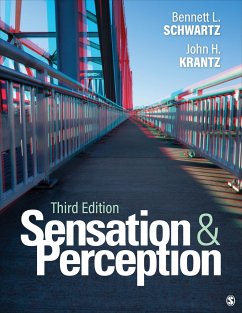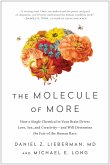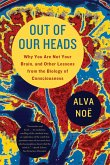- Broschiertes Buch
- Merkliste
- Auf die Merkliste
- Bewerten Bewerten
- Teilen
- Produkt teilen
- Produkterinnerung
- Produkterinnerung
Rich in examples and applications to everyday life, Sensation and Perception, Third Edition is a cutting edge and highly readable account of modern sensation and perception from both a cognitive and neurocognitive perspective.
Andere Kunden interessierten sich auch für
![Children′s Thinking Children′s Thinking]() David F BjorklundChildren′s Thinking148,99 €
David F BjorklundChildren′s Thinking148,99 €![The Molecule of More The Molecule of More]() Daniel Z LiebermanThe Molecule of More24,99 €
Daniel Z LiebermanThe Molecule of More24,99 €![Out of Our Heads Out of Our Heads]() Alva NoëOut of Our Heads15,99 €
Alva NoëOut of Our Heads15,99 €![On The Non-visual Perception Of The Length Of Lifted Rods On The Non-visual Perception Of The Length Of Lifted Rods]() Louis Benjamin HoisingtonOn The Non-visual Perception Of The Length Of Lifted Rods14,99 €
Louis Benjamin HoisingtonOn The Non-visual Perception Of The Length Of Lifted Rods14,99 €![The Cambridge Handbook of Applied Perception Research 2 Volume Hardback Set The Cambridge Handbook of Applied Perception Research 2 Volume Hardback Set]() The Cambridge Handbook of Applied Perception Research 2 Volume Hardback Set445,99 €
The Cambridge Handbook of Applied Perception Research 2 Volume Hardback Set445,99 €![The Cambridge Handbook of Applied Perception Research 2 Volume Paperback Set The Cambridge Handbook of Applied Perception Research 2 Volume Paperback Set]() The Cambridge Handbook of Applied Perception Research 2 Volume Paperback Set137,99 €
The Cambridge Handbook of Applied Perception Research 2 Volume Paperback Set137,99 €![Attention Attention]() Robert W ProctorAttention98,99 €
Robert W ProctorAttention98,99 €-
-
-
Rich in examples and applications to everyday life, Sensation and Perception, Third Edition is a cutting edge and highly readable account of modern sensation and perception from both a cognitive and neurocognitive perspective.
Produktdetails
- Produktdetails
- Verlag: Sage Publications
- 3rd edition
- Seitenzahl: 584
- Erscheinungstermin: 27. Juli 2023
- Englisch
- Abmessung: 278mm x 206mm x 14mm
- Gewicht: 440g
- ISBN-13: 9781071921180
- ISBN-10: 1071921185
- Artikelnr.: 67607784
- Herstellerkennzeichnung
- Libri GmbH
- Europaallee 1
- 36244 Bad Hersfeld
- gpsr@libri.de
- Verlag: Sage Publications
- 3rd edition
- Seitenzahl: 584
- Erscheinungstermin: 27. Juli 2023
- Englisch
- Abmessung: 278mm x 206mm x 14mm
- Gewicht: 440g
- ISBN-13: 9781071921180
- ISBN-10: 1071921185
- Artikelnr.: 67607784
- Herstellerkennzeichnung
- Libri GmbH
- Europaallee 1
- 36244 Bad Hersfeld
- gpsr@libri.de
Bennett L. Schwartz received his PhD in 1993 from Dartmouth College in New Hampshire. Since then he has been at Florida International University (FIU) in Miami, Florida, where he is currently professor of psychology. He is author or editor of 10 published books as well as over 70 journal articles and chapters. His textbook Memory: Foundations and Applications, fourth edition (SAGE), was published in 2020. He has won several teaching awards at FIU and currently teaches courses in memory, cognition, and sensation and perception. His main research area is metacognition and memory, but he has also conducted research in diverse areas that range from visual perception to evolutionary psychology, to the language of thought, and to memory in nonhuman primates. Schwartz currently serves as the editor in chief of New Ideas in Psychology.
ISLE Activities
Preface
Acknowledgments
About the Authors
Chapter 1: What Is Perception?
Introduction
Introduction to Sensation and Perception
The Basics of Perception
The History of Sensation and Perception
Neuroscience in Sensation and Perception
Chapter 2: Research Methodology
Introduction
Psychophysics: The Method of Limits
The Method of Constant Stimuli and the Method of Adjustment
Magnitude Estimation
Signal Detection Theory
Neuroimaging Techniques
Chapter 3: Visual System: The Eye
Introduction
Light
The Eye and Its Role in the Visual System
The Retina
The Duplex Theory of Vision
Retinal Ganglion Cells and Receptive Fields
Refractive Errors and Diseases of the Eye
Chapter 4: Visual System: The Brain
Introduction
The Optic Nerve, Chiasm, and the Lateral Geniculate Nucleus
The Superior Colliculus and the Primary Visual Cortex
Functional Pathways in the Visual Cortex
The Ventral and Dorsal Pathways in the Brain
Development of the Visual System
Chapter 5: Object Perception
Introduction
Introduction to Object Perception
Top-Down Processing and Bottom-Up Processing
Gestalt Psychology and Perceptual Organization
The Neuroanatomy and Physiology of Object Perception
Chapter 6: Color Perception
Introduction
Wavelengths of Light and Color
Additive and Subtractive Color Mixing
The Retina and Color
The Trichromatic Theory of Color Vision
The Opponent-Process Theory of Color Perception
The Development of Color Perception
Variations in Color Vision
Constancy: Lightness and Color Constancy
Chapter 7: Depth and Size Perception
Introduction
Monocular Depth Cues
Oculomotor Cues
Binocular Cues to Depth
Stereograms
Size Perception and Constancy
Visual Illusions of Size and Depth
Chapter 8: Movement and Action
Introduction
How Do We Perceive Motion?
Form Perception and Motion Perception: Detecting Global Motion
Action
The Neuroscience of Motion Perception
Chapter 9: Visual Attention
Introduction
Selective Attention
Spatial Limits of Attention
Stimulus Features That Draw Attention
Attention Over Time
The Anatomy and Physiology of Attention
Chapter 10: The Auditory System
Introduction
Sound as Stimulus
Anatomy of the Ear: The Outer Ear and the Middle Ear
Anatomy of the Ear: The Inner Ear
Chapter 11: The Auditory Brain and Sound Localization
Introduction
Brain Anatomy and the Pathway of Hearing
Localizing Sound
Auditory Scene Analysis
Chapter 12: Speech Perception
Introduction
The Human Voice as Stimulus
Variability in the Acoustics of Phonemes
Theories of Speech Perception
Speech Perception and the Brain
Chapter 13: Music Perception
Introduction
The Acoustics of Music
The Neuroscience of Music
Learning, Culture, and Music Perception
Chapter 14: Touch and Pain
Introduction
The Skin and Its Receptors
Neural Pathways
The Neurochemistry of Pain: Endogenous Opioids and the Perception of Itch
Haptic Perception
The Vestibular System: The Perception of Balance
Chapter 15: Olfaction and Taste
Introduction
Olfaction
Olfactory Perception
Taste Perception
Glossary
References
Author Index
Subject Index
Preface
Acknowledgments
About the Authors
Chapter 1: What Is Perception?
Introduction
Introduction to Sensation and Perception
The Basics of Perception
The History of Sensation and Perception
Neuroscience in Sensation and Perception
Chapter 2: Research Methodology
Introduction
Psychophysics: The Method of Limits
The Method of Constant Stimuli and the Method of Adjustment
Magnitude Estimation
Signal Detection Theory
Neuroimaging Techniques
Chapter 3: Visual System: The Eye
Introduction
Light
The Eye and Its Role in the Visual System
The Retina
The Duplex Theory of Vision
Retinal Ganglion Cells and Receptive Fields
Refractive Errors and Diseases of the Eye
Chapter 4: Visual System: The Brain
Introduction
The Optic Nerve, Chiasm, and the Lateral Geniculate Nucleus
The Superior Colliculus and the Primary Visual Cortex
Functional Pathways in the Visual Cortex
The Ventral and Dorsal Pathways in the Brain
Development of the Visual System
Chapter 5: Object Perception
Introduction
Introduction to Object Perception
Top-Down Processing and Bottom-Up Processing
Gestalt Psychology and Perceptual Organization
The Neuroanatomy and Physiology of Object Perception
Chapter 6: Color Perception
Introduction
Wavelengths of Light and Color
Additive and Subtractive Color Mixing
The Retina and Color
The Trichromatic Theory of Color Vision
The Opponent-Process Theory of Color Perception
The Development of Color Perception
Variations in Color Vision
Constancy: Lightness and Color Constancy
Chapter 7: Depth and Size Perception
Introduction
Monocular Depth Cues
Oculomotor Cues
Binocular Cues to Depth
Stereograms
Size Perception and Constancy
Visual Illusions of Size and Depth
Chapter 8: Movement and Action
Introduction
How Do We Perceive Motion?
Form Perception and Motion Perception: Detecting Global Motion
Action
The Neuroscience of Motion Perception
Chapter 9: Visual Attention
Introduction
Selective Attention
Spatial Limits of Attention
Stimulus Features That Draw Attention
Attention Over Time
The Anatomy and Physiology of Attention
Chapter 10: The Auditory System
Introduction
Sound as Stimulus
Anatomy of the Ear: The Outer Ear and the Middle Ear
Anatomy of the Ear: The Inner Ear
Chapter 11: The Auditory Brain and Sound Localization
Introduction
Brain Anatomy and the Pathway of Hearing
Localizing Sound
Auditory Scene Analysis
Chapter 12: Speech Perception
Introduction
The Human Voice as Stimulus
Variability in the Acoustics of Phonemes
Theories of Speech Perception
Speech Perception and the Brain
Chapter 13: Music Perception
Introduction
The Acoustics of Music
The Neuroscience of Music
Learning, Culture, and Music Perception
Chapter 14: Touch and Pain
Introduction
The Skin and Its Receptors
Neural Pathways
The Neurochemistry of Pain: Endogenous Opioids and the Perception of Itch
Haptic Perception
The Vestibular System: The Perception of Balance
Chapter 15: Olfaction and Taste
Introduction
Olfaction
Olfactory Perception
Taste Perception
Glossary
References
Author Index
Subject Index
ISLE Activities
Preface
Acknowledgments
About the Authors
Chapter 1: What Is Perception?
Introduction
Introduction to Sensation and Perception
The Basics of Perception
The History of Sensation and Perception
Neuroscience in Sensation and Perception
Chapter 2: Research Methodology
Introduction
Psychophysics: The Method of Limits
The Method of Constant Stimuli and the Method of Adjustment
Magnitude Estimation
Signal Detection Theory
Neuroimaging Techniques
Chapter 3: Visual System: The Eye
Introduction
Light
The Eye and Its Role in the Visual System
The Retina
The Duplex Theory of Vision
Retinal Ganglion Cells and Receptive Fields
Refractive Errors and Diseases of the Eye
Chapter 4: Visual System: The Brain
Introduction
The Optic Nerve, Chiasm, and the Lateral Geniculate Nucleus
The Superior Colliculus and the Primary Visual Cortex
Functional Pathways in the Visual Cortex
The Ventral and Dorsal Pathways in the Brain
Development of the Visual System
Chapter 5: Object Perception
Introduction
Introduction to Object Perception
Top-Down Processing and Bottom-Up Processing
Gestalt Psychology and Perceptual Organization
The Neuroanatomy and Physiology of Object Perception
Chapter 6: Color Perception
Introduction
Wavelengths of Light and Color
Additive and Subtractive Color Mixing
The Retina and Color
The Trichromatic Theory of Color Vision
The Opponent-Process Theory of Color Perception
The Development of Color Perception
Variations in Color Vision
Constancy: Lightness and Color Constancy
Chapter 7: Depth and Size Perception
Introduction
Monocular Depth Cues
Oculomotor Cues
Binocular Cues to Depth
Stereograms
Size Perception and Constancy
Visual Illusions of Size and Depth
Chapter 8: Movement and Action
Introduction
How Do We Perceive Motion?
Form Perception and Motion Perception: Detecting Global Motion
Action
The Neuroscience of Motion Perception
Chapter 9: Visual Attention
Introduction
Selective Attention
Spatial Limits of Attention
Stimulus Features That Draw Attention
Attention Over Time
The Anatomy and Physiology of Attention
Chapter 10: The Auditory System
Introduction
Sound as Stimulus
Anatomy of the Ear: The Outer Ear and the Middle Ear
Anatomy of the Ear: The Inner Ear
Chapter 11: The Auditory Brain and Sound Localization
Introduction
Brain Anatomy and the Pathway of Hearing
Localizing Sound
Auditory Scene Analysis
Chapter 12: Speech Perception
Introduction
The Human Voice as Stimulus
Variability in the Acoustics of Phonemes
Theories of Speech Perception
Speech Perception and the Brain
Chapter 13: Music Perception
Introduction
The Acoustics of Music
The Neuroscience of Music
Learning, Culture, and Music Perception
Chapter 14: Touch and Pain
Introduction
The Skin and Its Receptors
Neural Pathways
The Neurochemistry of Pain: Endogenous Opioids and the Perception of Itch
Haptic Perception
The Vestibular System: The Perception of Balance
Chapter 15: Olfaction and Taste
Introduction
Olfaction
Olfactory Perception
Taste Perception
Glossary
References
Author Index
Subject Index
Preface
Acknowledgments
About the Authors
Chapter 1: What Is Perception?
Introduction
Introduction to Sensation and Perception
The Basics of Perception
The History of Sensation and Perception
Neuroscience in Sensation and Perception
Chapter 2: Research Methodology
Introduction
Psychophysics: The Method of Limits
The Method of Constant Stimuli and the Method of Adjustment
Magnitude Estimation
Signal Detection Theory
Neuroimaging Techniques
Chapter 3: Visual System: The Eye
Introduction
Light
The Eye and Its Role in the Visual System
The Retina
The Duplex Theory of Vision
Retinal Ganglion Cells and Receptive Fields
Refractive Errors and Diseases of the Eye
Chapter 4: Visual System: The Brain
Introduction
The Optic Nerve, Chiasm, and the Lateral Geniculate Nucleus
The Superior Colliculus and the Primary Visual Cortex
Functional Pathways in the Visual Cortex
The Ventral and Dorsal Pathways in the Brain
Development of the Visual System
Chapter 5: Object Perception
Introduction
Introduction to Object Perception
Top-Down Processing and Bottom-Up Processing
Gestalt Psychology and Perceptual Organization
The Neuroanatomy and Physiology of Object Perception
Chapter 6: Color Perception
Introduction
Wavelengths of Light and Color
Additive and Subtractive Color Mixing
The Retina and Color
The Trichromatic Theory of Color Vision
The Opponent-Process Theory of Color Perception
The Development of Color Perception
Variations in Color Vision
Constancy: Lightness and Color Constancy
Chapter 7: Depth and Size Perception
Introduction
Monocular Depth Cues
Oculomotor Cues
Binocular Cues to Depth
Stereograms
Size Perception and Constancy
Visual Illusions of Size and Depth
Chapter 8: Movement and Action
Introduction
How Do We Perceive Motion?
Form Perception and Motion Perception: Detecting Global Motion
Action
The Neuroscience of Motion Perception
Chapter 9: Visual Attention
Introduction
Selective Attention
Spatial Limits of Attention
Stimulus Features That Draw Attention
Attention Over Time
The Anatomy and Physiology of Attention
Chapter 10: The Auditory System
Introduction
Sound as Stimulus
Anatomy of the Ear: The Outer Ear and the Middle Ear
Anatomy of the Ear: The Inner Ear
Chapter 11: The Auditory Brain and Sound Localization
Introduction
Brain Anatomy and the Pathway of Hearing
Localizing Sound
Auditory Scene Analysis
Chapter 12: Speech Perception
Introduction
The Human Voice as Stimulus
Variability in the Acoustics of Phonemes
Theories of Speech Perception
Speech Perception and the Brain
Chapter 13: Music Perception
Introduction
The Acoustics of Music
The Neuroscience of Music
Learning, Culture, and Music Perception
Chapter 14: Touch and Pain
Introduction
The Skin and Its Receptors
Neural Pathways
The Neurochemistry of Pain: Endogenous Opioids and the Perception of Itch
Haptic Perception
The Vestibular System: The Perception of Balance
Chapter 15: Olfaction and Taste
Introduction
Olfaction
Olfactory Perception
Taste Perception
Glossary
References
Author Index
Subject Index








